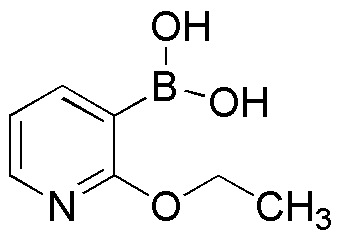2-Ethoxypyridine-3-boronic acid is widely utilized in research focused on:
- Drug Development: This compound serves as a crucial building block in the synthesis of various pharmaceuticals, particularly in developing targeted therapies for cancer and other diseases.
- Organic Synthesis: It is employed in cross-coupling reactions, such as Suzuki-Miyaura coupling, which is vital for creating complex organic molecules used in agrochemicals and fine chemicals.
- Material Science: The compound is used in the development of advanced materials, including polymers and nanomaterials, enhancing properties like strength and conductivity.
- Bioconjugation: It plays a role in bioconjugation processes, allowing researchers to attach biomolecules to surfaces or other molecules, which is essential in diagnostics and therapeutic applications.
- Analytical Chemistry: The compound is utilized in the preparation of sensors and probes for detecting specific biomolecules, aiding in environmental monitoring and medical diagnostics.
General Information
Properties
Safety and Regulations
Applications
2-Ethoxypyridine-3-boronic acid is widely utilized in research focused on:
- Drug Development: This compound serves as a crucial building block in the synthesis of various pharmaceuticals, particularly in developing targeted therapies for cancer and other diseases.
- Organic Synthesis: It is employed in cross-coupling reactions, such as Suzuki-Miyaura coupling, which is vital for creating complex organic molecules used in agrochemicals and fine chemicals.
- Material Science: The compound is used in the development of advanced materials, including polymers and nanomaterials, enhancing properties like strength and conductivity.
- Bioconjugation: It plays a role in bioconjugation processes, allowing researchers to attach biomolecules to surfaces or other molecules, which is essential in diagnostics and therapeutic applications.
- Analytical Chemistry: The compound is utilized in the preparation of sensors and probes for detecting specific biomolecules, aiding in environmental monitoring and medical diagnostics.
Documents
Safety Data Sheets (SDS)
The SDS provides comprehensive safety information on handling, storage, and disposal of the product.
Product Specification (PS)
The PS provides a comprehensive breakdown of the product’s properties, including chemical composition, physical state, purity, and storage requirements. It also details acceptable quality ranges and the product's intended applications.
Certificates of Analysis (COA)
Search for Certificates of Analysis (COA) by entering the products Lot Number. Lot and Batch Numbers can be found on a product’s label following the words ‘Lot’ or ‘Batch’.
Numéro de catalogue
Numéro de lot/série
Certificates Of Origin (COO)
This COO confirms the country where the product was manufactured, and also details the materials and components used in it and whether it is derived from natural, synthetic, or other specific sources. This certificate may be required for customs, trade, and regulatory compliance.
Numéro de catalogue
Numéro de lot/série
Safety Data Sheets (SDS)
The SDS provides comprehensive safety information on handling, storage, and disposal of the product.
DownloadProduct Specification (PS)
The PS provides a comprehensive breakdown of the product’s properties, including chemical composition, physical state, purity, and storage requirements. It also details acceptable quality ranges and the product's intended applications.
DownloadCertificates of Analysis (COA)
Search for Certificates of Analysis (COA) by entering the products Lot Number. Lot and Batch Numbers can be found on a product’s label following the words ‘Lot’ or ‘Batch’.
Numéro de catalogue
Numéro de lot/série
Certificates Of Origin (COO)
This COO confirms the country where the product was manufactured, and also details the materials and components used in it and whether it is derived from natural, synthetic, or other specific sources. This certificate may be required for customs, trade, and regulatory compliance.


